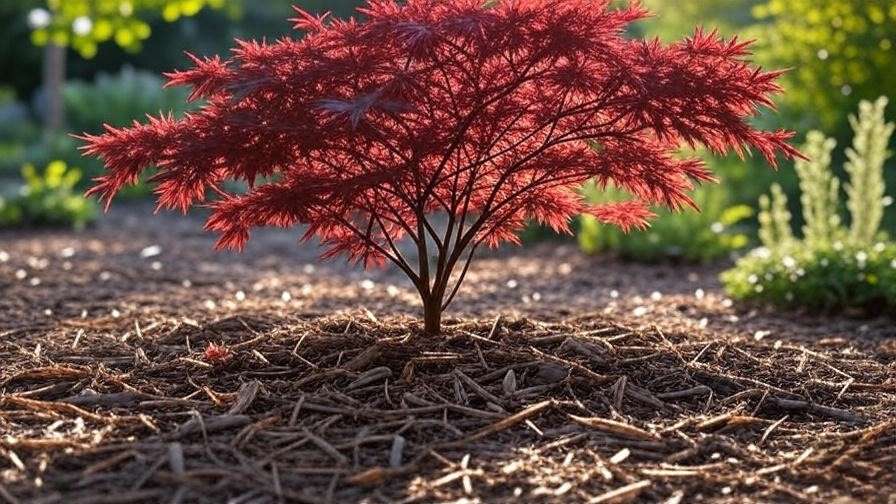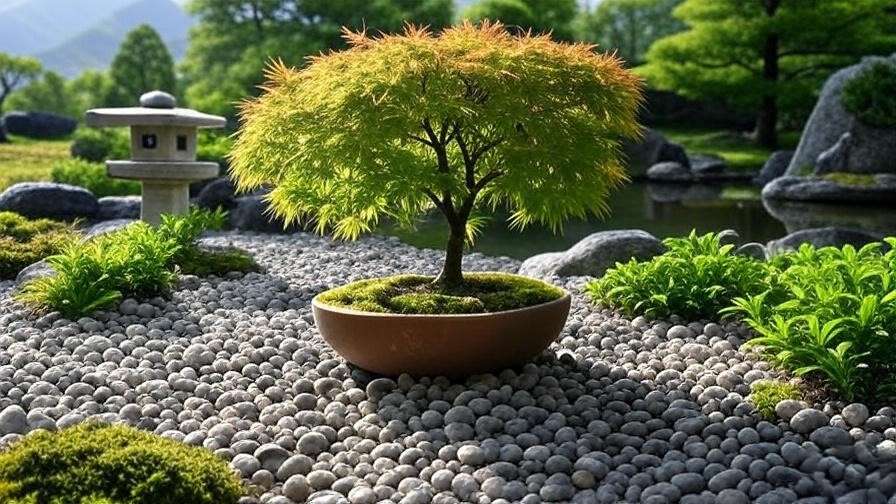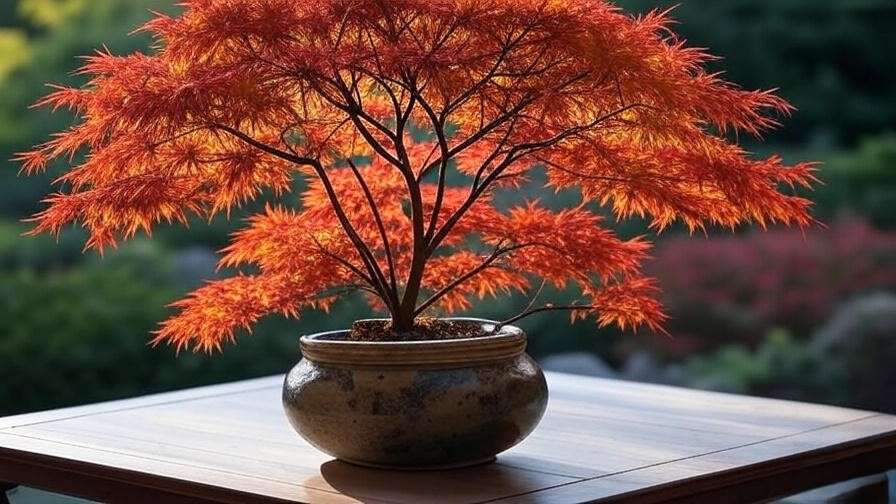Imagine transforming your patio or balcony into a vibrant oasis with the delicate, fiery foliage of a Japanese maple tree in a pot—a showstopper that brings elegance to any small space! These iconic trees, known for their intricate leaves and stunning seasonal colors, are perfect for container gardening, offering flexibility for urban dwellers or anyone with limited garden space. Whether you’re a beginner or a seasoned gardener, growing a Japanese maple in a pot can be both rewarding and surprisingly manageable with the right knowledge. In this comprehensive guide, we’ll walk you through expert-backed steps to cultivate a healthy, breathtaking Japanese maple that thrives year-round. From selecting the perfect variety to mastering care routines, this article solves the challenge of creating a vibrant, portable masterpiece for your home. 🌳
1. Why Choose a Japanese Maple Tree in a Pot? 🌳
1.1 The Beauty of Japanese Maples in Containers
Japanese maples (Acer palmatum) are celebrated for their delicate, lacy leaves and vibrant hues—think fiery reds, golden yellows, and deep purples that shift with the seasons. When grown in pots, these trees become portable works of art, ideal for patios, balconies, or cozy courtyards. Their compact size and graceful structure make them a favorite for adding elegance to small spaces. Unlike larger trees, potted Japanese maples allow you to showcase their beauty up close, creating a focal point that elevates your outdoor aesthetic. 🌞
1.2 Benefits of Growing in Pots vs. In-Ground
Growing a Japanese maple in a container offers unique advantages:
- Control Over Conditions: Pots allow you to customize soil, drainage, and location, ensuring optimal growth.
- Portability: Move your tree to capture the best sunlight or protect it from harsh weather.
- Space-Saving: Perfect for urban gardeners or those with limited yard space.
- Seasonal Flexibility: Display your tree as a centerpiece during its vibrant fall color phase.
Expert Tip: “I’ve grown Japanese maples in pots for over a decade,” says horticulturist Jane Yamada of Green Haven Nursery. “Their adaptability makes them a joy for small-space gardeners.” 🌟
2. Selecting the Right Japanese Maple Variety for Pots 🪴
2.1 Top Dwarf and Compact Varieties
Not all Japanese maples are suited for container life, but dwarf and compact varieties thrive in pots. Here are some top picks:
| Variety | Height | Leaf Color | Best For |
|---|---|---|---|
| Acer palmatum ‘Shaina’ | 4–6 ft | Deep red | Compact spaces, vivid color |
| Acer palmatum ‘Katsura’ | 5–7 ft | Yellow-orange to green | Early spring vibrancy |
| Acer palmatum ‘Rhode Island Red’ | 5–6 ft | Crimson red | Bold fall displays |
These varieties stay small, with manageable root systems, making them ideal for containers. Their slow growth ensures they won’t outgrow their pots too quickly.

2.2 Considerations for Choosing a Variety
When selecting a Japanese maple, consider:
- Climate: Most Japanese maples thrive in USDA Zones 5–8. Check your zone to ensure compatibility.
- Aesthetic Preferences: Choose based on leaf shape (e.g., palmate or laceleaf) and seasonal color changes.
- Growth Habit: Upright varieties suit formal displays, while weeping forms create a cascading effect.
Pro Insight: According to a 2023 study by the University of Georgia Extension, dwarf varieties like ‘Shaina’ are particularly resilient in containers due to their compact root systems. 📊
3. Choosing the Perfect Pot for Your Japanese Maple 🏺
3.1 Size and Material Matters
The right pot sets the foundation for a healthy Japanese maple. Aim for a container at least 18–24 inches in diameter for young trees, increasing to 30 inches for mature ones. Ensure the pot has drainage holes to prevent root rot—a common issue in poorly drained containers.
Pot Material Pros and Cons:
- Ceramic: Stylish and durable but heavy; ideal for stable locations.
- Terracotta: Breathable and classic but prone to cracking in cold climates.
- Plastic/Fiberglass: Lightweight and affordable but may retain heat.

3.2 Design and Aesthetic Considerations
Choose a pot that complements the tree’s elegance. Glazed ceramic in muted tones enhances vibrant foliage, while simple terracotta suits minimalist designs. Ensure the pot is sturdy to prevent tipping in windy conditions, especially for taller varieties.
Quick Tip: Use a pot with a wide base for stability and add a layer of gravel at the bottom to improve drainage. 🖼️
4. Soil and Planting Essentials 🌱
4.1 Best Soil Mix for Japanese Maples
Japanese maples thrive in well-draining, slightly acidic soil (pH 5.5–6.5). A DIY soil mix works best:
- 40% peat moss or compost (for organic matter).
- 30% perlite or pumice (for drainage).
- 30% loamy garden soil or potting mix (for structure).
Avoid heavy clay soils that retain water, as they can suffocate roots.
4.2 Step-by-Step Planting Guide
- Prepare the Pot: Clean the pot thoroughly and add a layer of drainage material (e.g., broken pottery or pebbles).
- Add Soil: Fill the pot halfway with your soil mix.
- Position the Tree: Place the tree’s root ball in the center, ensuring the graft union (if present) is above soil level.
- Fill and Firm: Add remaining soil, gently pressing to eliminate air pockets.
- Water Thoroughly: Soak the soil to settle roots, ensuring excess water drains.
Expert Example: Arborist Tom Nguyen shares, “When I planted my ‘Katsura’ in a ceramic pot, I used a 1-inch layer of gravel to boost drainage—five years later, it’s thriving!” 🌳

5. Watering and Feeding Your Potted Japanese Maple 💧
5.1 Watering Best Practices
Consistent moisture is key, but overwatering is a common mistake. Check the top inch of soil; water when it feels dry. In summer, you may need to water every 1–2 days, while in cooler months, once a week may suffice. Watch for signs of trouble:
- Overwatering: Yellowing leaves, soggy soil.
- Underwatering: Wilting, crispy leaf edges.
Use a watering can with a fine spout to avoid disturbing the soil.
5.2 Fertilizing for Vibrant Growth
Feed your Japanese maple sparingly to avoid leaf burn. Use a slow-release, low-nitrogen fertilizer (e.g., 10-10-10 or 5-10-5) in early spring and again in early summer. Over-fertilizing can lead to weak growth or scorched leaves.
Pro Tip: Create a seasonal watering and feeding schedule to stay consistent. Here’s a quick guide:
| Season | Watering Frequency | Fertilizing |
|---|---|---|
| Spring | Every 2–3 days | Apply slow-release fertilizer |
| Summer | Every 1–2 days | Light feeding mid-season |
| Fall | Every 4–5 days | None |
| Winter | Weekly or less | None |
6. Light and Location Requirements ☀️
6.1 Ideal Sunlight Conditions
Japanese maples in pots thrive in a balance of light and shade. Aim for morning sun and afternoon shade to prevent leaf scorch, especially in warmer climates. In cooler regions (USDA Zones 5–6), they can tolerate more direct sunlight, but in hotter areas (Zones 7–8), filtered light or partial shade is ideal. Rotate the pot every few weeks to ensure even growth and prevent lopsided development.
If you’re unsure about your garden’s light conditions, observe the tree’s leaves:
- Too much sun: Brown, crispy edges or faded colors.
- Too little sun: Pale leaves or leggy growth.

6.2 Protecting from Extreme Weather
Potted Japanese maples are more vulnerable to temperature extremes than in-ground trees. Here’s how to protect them:
- Summer Heat: Move the pot to a shaded spot during heatwaves or use a shade cloth to diffuse intense sunlight.
- Winter Cold: In colder climates, wrap the pot in burlap or bubble wrap to insulate roots. Alternatively, move the pot to a sheltered area, like a garage or covered porch, during freezing temperatures.
- Wind: Place the pot in a wind-sheltered location to prevent tipping or leaf damage.
Real-World Insight: Gardener Sarah Thompson from Vermont (Zone 5) shares, “I move my ‘Rhode Island Red’ to a shaded patio in summer and a garage in winter—it’s been thriving for six years!” 🌦️
7. Pruning and Maintenance for Healthy Growth ✂️
7.1 When and How to Prune
Pruning keeps your Japanese maple shapely and healthy. The best time to prune is late winter or early spring before new growth begins, as the tree is dormant and sap flow is minimal. Follow these steps:
- Remove Dead or Damaged Branches: Use clean, sharp pruning shears to cut back any dead, diseased, or crossing branches.
- Shape the Tree: Trim lightly to maintain the desired form (e.g., upright or weeping). Avoid heavy pruning, as Japanese maples grow slowly.
- Sanitize Tools: Clean shears with rubbing alcohol between cuts to prevent disease spread.
7.2 Common Maintenance Tasks
Regular maintenance ensures long-term health:
- Leaf Cleanup: Remove fallen or dead leaves to prevent fungal growth.
- Pest Checks: Inspect for pests like aphids or scale insects, especially in spring and summer.
- Repotting: Every 2–3 years, repot to refresh soil and prevent root-bound conditions. Choose a slightly larger pot and trim any circling roots.
Expert Advice: Use this pruning checklist for beginners:
- ✅ Sterilize tools.
- ✅ Prune in late winter.
- ✅ Remove no more than 20% of the canopy.
- ✅ Step back to assess shape after each cut. 📋
8. Troubleshooting Common Problems 🐞
8.1 Addressing Leaf Scorch and Wilting
Leaf scorch and wilting are common issues for potted Japanese maples. Here’s how to diagnose and fix them:
- Leaf Scorch:
- Causes: Excessive sun, underwatering, or poor drainage.
- Solutions: Move to a shadier spot, increase watering frequency, and ensure proper drainage.
- Wilting:
- Causes: Underwatering, root rot, or heat stress.
- Solutions: Check soil moisture, improve drainage, and provide temporary shade during heatwaves.
8.2 Managing Pests and Diseases
Japanese maples are relatively pest-resistant but can face issues:
- Pests: Aphids and spider mites are common. Use neem oil or insecticidal soap for organic control.
- Diseases: Verticillium wilt (a soil-borne fungus) can cause wilting or branch dieback. Prevent it by ensuring good air circulation and avoiding overwatering.
Helpful Resource: For pest identification, refer to the University of California’s Integrated Pest Management Program (ipm.ucanr.edu). 🔍
9. Seasonal Care for Year-Round Beauty 🍁
9.1 Spring and Summer Care
Spring and summer are active growth periods:
- Watering: Increase frequency during warm weather, ensuring soil stays consistently moist but not soggy.
- Feeding: Apply a balanced fertilizer in early spring to boost growth.
- Pest Monitoring: Check weekly for pests, as warmer weather encourages infestations.
9.2 Fall and Winter Care
Fall showcases the Japanese maple’s stunning colors, while winter requires protection:
- Fall: Reduce watering as growth slows. Enjoy the vibrant foliage by placing the pot in a prominent spot.
- Winter: Minimize watering to prevent root rot. Insulate the pot with mulch or burlap in cold climates to protect roots from freezing.
Seasonal Tip: Use this month-by-month care calendar:
| Month | Care Tasks |
|---|---|
| March–May | Fertilize, prune, increase watering |
| June–August | Monitor for pests, provide shade, water frequently |
| September–November | Reduce watering, showcase fall colors |
| December–February | Protect from cold, water sparingly |
10. Design Ideas: Styling Your Potted Japanese Maple 🎍
A potted Japanese maple can transform your space into a serene retreat. Try these ideas:
- Patio Focal Point: Place a vibrant ‘Shaina’ in a glazed ceramic pot as a centerpiece.
- Zen Garden Accent: Pair with smooth pebbles, a small lantern, or low-growing ferns for a Japanese-inspired look.
- Entryway Elegance: Flank your front door with two matching pots of weeping Japanese maples for symmetry.

Inspiration: Check out reader-submitted photos on gardening forums like GardenWeb for creative setups. A popular idea is combining a red-leaved maple with white-flowering perennials for contrast. 🖼️
11. FAQs About Growing Japanese Maples in Pots ❓
Q: How long can a Japanese maple live in a pot?
A: With proper care, a potted Japanese maple can thrive for 20–30 years or more. Regular repotting and root maintenance are key.
Q: Can I grow a Japanese maple indoors?
A: Japanese maples prefer outdoor conditions but can survive indoors temporarily if given bright, indirect light and high humidity. Long-term indoor growth is challenging.
Q: How often should I repot my tree?
A: Repot every 2–3 years to refresh soil and prevent root-bound issues. Choose a pot 2–4 inches larger in diameter.
Q: What’s the best way to prevent leaf scorch?
A: Provide morning sun and afternoon shade, ensure consistent watering, and use a well-draining soil mix.
12. Conclusion: Your Journey to a Thriving Japanese Maple 🌟
Growing a Japanese maple tree in a pot is a rewarding way to bring elegance and vibrant color to your home, no matter the size of your space. By choosing the right variety, pot, and soil, and following a consistent care routine—watering, feeding, pruning, and protecting—you can cultivate a stunning tree that thrives for years. Start your journey today by selecting a dwarf variety like ‘Katsura’ or ‘Shaina,’ and watch your patio transform into a living masterpiece. Have questions or tips of your own? Share them in the comments below or explore our related guides on container gardening and ornamental trees. Happy gardening! 🌿













